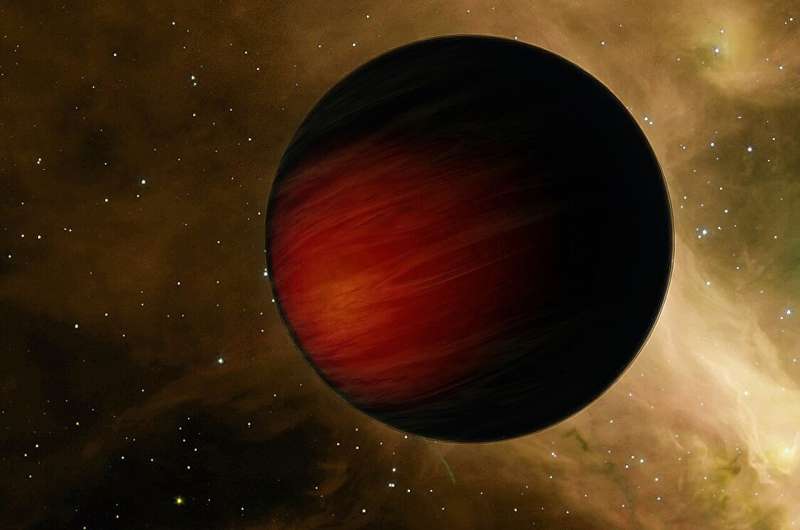
Artist’s impression of Smertrios. Credit: NASA.
Using the CARMENES spectrograph, astronomers have found evidence of water vapor in the atmosphere of a hot Saturnian exoplanet called HD 149026 b, dubbed Smertrios. The finding, reported in a research paper published on the preprint server arXivcould hold the key to a better understanding of the structure and origins of this alien world.
Smertrios is a metal-rich, hot Saturn orbiting HD 149026, a yellow subgiant of spectral type G0 IV, at a distance of about 248.5 light-years. The planet has a radius of about 0.81 Jupiter radii and is about three times smaller than Jupiter. Previous observations have shown that Smertrios orbits its host planet every 2.876 days, at a distance of about 0.043 AU. The planet’s equilibrium temperature is estimated to be 1,693 K.
The team of astronomers led by Sayyed A. Rafi of the University of Tokyo in Japan used CARMENES at the Calar-Alto Observatory to perform high-resolution cross-correlation spectroscopy of Smertrios. Their main goal was to gain a better understanding of the composition of the exoplanet’s atmosphere.
“Transmission spectroscopy is one of the most successful approaches for studying the atmospheres of exoplanets. We analyzed the near-infrared high-resolution transmission spectrum of a hot Saturn, HD 149026 b, taken using the CARMENES spectrograph,” the researchers wrote in the paper.
By analyzing the CARMENES data, Rafi’s team found evidence of a water signal very close to the expected location of Smertrios. The strongest signal had a signal-to-noise ratio (S/N) of 4.8. The astronomers noted that at this time, the detected signal could only be considered evidence of the existence of water vapor, not a confirmed detection.
According to the study, evidence of water vapor in Smertrios’ atmosphere suggests that the carbon/oxygen ratio on the planet must be less than one if the atmosphere is homogeneous and in chemical equilibrium, as the amount of hydrogen cyanide is expected to be very low.
Although the researchers searched for hydrogen cyanide in the atmosphere of Smertrios, they found no evidence for this compound. The astronomers assume that this could be due to the relatively low S/N data set. Therefore, the possibility of hydrogen cyanide in the atmosphere of this planet cannot be definitively ruled out.
The study also measured the orbital and resting velocities of Smertrios, which were found to be approximately 158.17 and 2.57 km/s, respectively. However, it was noted that while the orbital velocity is consistent with the expected value, the resting velocity is strongly redshifted. The authors of the paper concluded that this could be explained by several scenarios, such as anomalous atmospheric dynamics or an orbit with non-zero eccentricity.
More information:
Sayyed A. Rafi et al, Evidence for water vapor in the atmosphere of a metal-rich hot Saturn using high-resolution transmission spectroscopy, arXiv (2024). DOI number: 10.48550/arxiv.2407.01266
Magazine information:
arXiv
© 2024 Science X Network
Quote: Evidence of water vapor detected in Smertrios atmosphere (2024, July 9) Retrieved July 9, 2024, from https://phys.org/news/2024-07-evidence-vapor-atmosphere-smertrios.html
This document is subject to copyright. Except for fair dealing for private study or research, no part may be reproduced without written permission. The contents are supplied for information purposes only.
